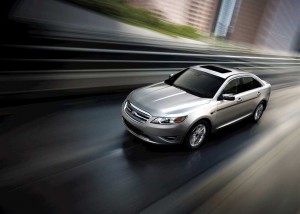
Can the 2010 Ford Taurus live up to the legend created by the original 1986 sedan?
When you consider the countless number of cars that come to market, each year, only a handful ever really make all that much of a difference – a handful for any individual automaker. For Ford, the list would include the Model T, of course, and the Mustang. And most recently, the Taurus — the original 1986 version, that is.
But by the time Ford pulled the plug on the Taurus brand, a few years back, what was once significant had grown merely simpering, a product that only the rental car fleets could love. Overall, since 2004, Ford has lost more than 5 percentage points market share, as record-making losses ensued.
Now, the Taurus name is back, and for 2010, Ford has attached it to another product that the automaker hopes will stand out in a crowded automotive market. We’ve finally had the chance to test the 2010 Ford Taurus, and its sibling sedan, the 2010 Taurus SHO. We’ll take a look at the base car, then follow, tomorrow, with an in-depth report on the reborn performance sedan.
 While the 2010 Taurus doesn’t quite have the visual stopping power of the original, it is nonetheless a product likely to garner significant attention for Ford, which is notably the only Detroit maker to reject the idea of a federal bailout because it had already borrowed more than $20 billion from the credit markets before they collapsed. That, alone, is winning Ford friends. But while some import-oriented shoppers may be once again looking at the line-up in Ford showrooms, it’s only a truly significant product that will win them back. And the ’10 Taurus may be precisely what Ford needs.
While the 2010 Taurus doesn’t quite have the visual stopping power of the original, it is nonetheless a product likely to garner significant attention for Ford, which is notably the only Detroit maker to reject the idea of a federal bailout because it had already borrowed more than $20 billion from the credit markets before they collapsed. That, alone, is winning Ford friends. But while some import-oriented shoppers may be once again looking at the line-up in Ford showrooms, it’s only a truly significant product that will win them back. And the ’10 Taurus may be precisely what Ford needs.
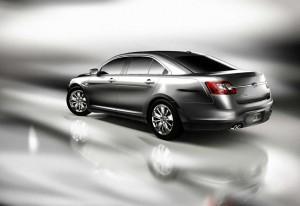
The 2010 Ford Taurus shares the same platform as the Lincoln MKS, though there will be no Mercury Sable spin-off, unlike with past generations of the Taurus sedan.
Some products invite, even demand, comparison. That’s true of the 2010 Ford Taurus, though the model it’s most likely to be compared with is the ’86 original. That car was a visual stand-out. To fans, it brought in the era of the aero-car, styling designed to notonly be attractive based on am Audi sedan, but to save fuel by cheating the wind. To critics, it was the first” jellybean car.” Perhaps more significant was the functional leap the ’86 Taurus took. The sedan offered great dimensions, and a seemingly endless list of useful features. It surprised and delighted every where you looked.
The 2010 Ford Taurus is not quite as distinctive. It doesn’t bring us an all-new school of automotive design, but it’s nonetheless a handome car, with a dramatic front end built around the automaker’s now signature three-bar grille. The car is more solid and upright than both the ’86 and the ovoid model that transformed the Taurus into a rent-a-car mainstay.
It’s also a fair bit bigger, the new sedan sharing the same, Volvo-derived platform as the more luxurious Lincoln MKS – as well as the outgoing Taurus — and falling into the full-size category. That puts it up against bigger more expensive imports, such as the Toyota Avalon, while the original Ford was a midsize and targeted the likes of the Camry and Honda Accord. Whether Ford can move the Taurus brand name up into the $30,000 ot $40,000 range is an open question.
Inside, there’s room for five, though despite the full-size designation, the cabin is less roomy than one would expect, and shows that Taurus is no longer perceived as a “family car.” If that’s what you have in mind, the company seems to be saying, opt for an Explorer SUV or an Edge crossover. There’s a more sporty, personalized feel to the Taurus cockpit, and we imagine most buyers will see it as a four-seater for most applications.
One place the Taurus is unabashedly full-size is in the trunk, which is big enough for perhaps six large golf bags. Why, though, did Ford forget to design in a grab handle to make it easier to close the trunk lid without grabbing dirty or wet sheet metal?
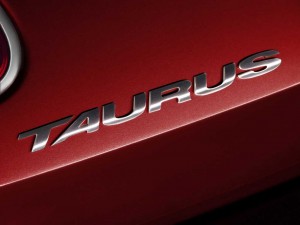
The badge may be the same, but there are some big differences between the original Taurus and the 2010 version. For one thing, the new car is a full-size, rather than midsize sedan.
The ’86 delivered a surprising number of so-called “surprise-and-delight” interior features, some as simple as the double sun visors that could be positioned to block glare from both the front and side.
The 2010’s cabin is well laid out, with an elegant use of materials. Most of the surfaces you’ll come in contact with are soft touch. Gaps are minimal and consistent. The seats are comfortable yet supportive. The center console is set at a more stylishly raked angle than is typical for Ford. It’s a more attractive design – and more functional, bringing key controls right within easy reach.
But when it comes to surprising and delighting, Ford has, for one thing, put a premium on cabin quietness. Taurus engineers have turned to an assortment of new production systems and materials, such as laminated windshield and side window glass, and foams that fill up the gaps between body panels to soak up even the loudest wind and road noises. Never mind Toyota, if you’ve got a VU meter in hand, you’re likely to find the 2010 Ford Taurus stacks up in the noise category against the traditional benchmark, Lexus.
Another nice touch can be found in the way the new Taurus interior is lit. Switches feature ice blue backlighting, making it easy to find them at night. Then there’s the elegant ambient lighting in places like the footwells and doors, with a driver able to opt for any of seven different colors.
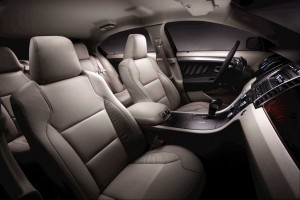
The new Taurus interior is more cockpit and less the sort of family-focused cabin of the past.
One of the more unusual surprises came when we switched on Taurus’s Active Motion front seats. While some luxury cars offer seats that’ll massage your back while driving, Ford has chosen to offer a more gentle motion designed to more subtly knead your lower back and butt, which it insists will reduce stress during long drives. It takes a little while to get used to the sensation, but it did appear to work, reducing fatigue during a long day on the road.
There’s also a long list of standard and optional technology the original Taurus development team couldn’t have begun to imagine, features that, in many instances, have until now only been offered on high-line luxury products, such as the newest BMW 7-Series.
That includes such niceties as radar-powered Adaptive Cruise Control, which lets you set a preferred speed, then adjusts it according to traffic flow. A collision warning system alerts the driver to a potential crash, then intervenes, if necessary, to minimize the impact. Many cars now offer a blind spot warning system, but Ford is the first mainstream maker with Cross Traffic Alert. If you’re backing out of a spot, it uses a pair of rear fender-mounted radar modules to scan the road for traffic coming from either side.
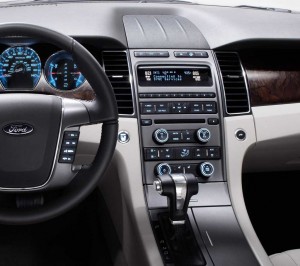
The 2010 Ford Taurus features the 3rd generation of the automaker's SYNC infotainment system.
The new Taurus is loaded with safety technology, including the usual assortment of airbags, ABS, stability control, and traction control. Company officials lay claim to Taurus being the “safest full-sized car in America,” in fact.
But much of the new technology is also geared towards comfort and convenience, such as the Gen 3 SYNC system. Ford has garnered plenty of kudos for SYNC, especially from younger buyers, which it developed in cooperation with Microsoft. It’s about the friendliest system on the market when it comes to programming navigation coordinates or setting up a hands-free Bluetooth cellphone. If you don’t opt for the large LCD screen, you’ll still get turn-by-turn navigation. Add the navi screen and you get a three-year subscription to Sirius Travel Link, which delivers traffic, weather, alternative routing and other personalized features, such as tracking the cheapest nearby gas pumps.
Among the numerous options are a 390-watt Sony sound system, automatic high beams, rain-sensing wipers and a rear power sun shade.
Perhaps surprisingly, there’s only one powertrain package – unless you migrate up to the SHO. But there’s not much to complain about with Ford’s all aluminum, 3.5-liter Duratec V-6. It makes an impressive 263 horsepower and 249 pound-feet of torque, hits 60 in about 7 seconds, and delivers 18 mpg in the City, 28 on the Highway. Front-wheel-drive is standard, but all-wheel-drive is an option likely to gain high acceptance in snowier climes. The engine is mated to a 6-speed automatic gearbox, and on the mid SEL and top-line Limited editions, you’ll get steering wheel-mounted paddle shifters.
The engine has a nice amount of pep and can really move the metal, despite the new Taurus’s heft. You’ll barely hear the Duratec engine, even under wide-open throttle, thanks to all that focus on noise reduction. That’s no loss, as one weakness of this powertrain is a rather brittle exhaust note. One other minor complaint is that you have to shift into “manumatic” to activate the paddle shifters. We’d prefer to have it set up so you can tap the paddles and briefly go into manumatic mode for, say, a sharp corner, and then have the system time out and return to fully automatic mode, 10 or 20 seconds later.
The 2010 Ford Taurus features a reasonably good hydraulic power-assisted power steering system. The on-center feel is precise and the overall system is responsive considering the size of the sedan, though you will get a fair bit of understeer should you press it hard. This is a very heavy car. Driving through some tight mountain passes in Tennessee and North Carolina, we were nonetheless able to flog the four-door through turns a lot more quickly than with big competitors, like the Avalon. A new front suspension tuning and stability bars reportedly yield 20% less body roll, which is immediately apparent in sharp corners.
New, larger brakes scrub off speed fast, though they will fade a bit if you push the car hard, with constant high-speed braking maneuvers.
In all, there’s a lot to like about the new Taurus. But how much does it all add up to? Ford is bringing in the base 2010 Taurus SE at $25,995, the same as the old ’09, which was little more than a renamed – and largely unloved — Ford Five Hundred. The mid-range SEL, which is likely to be the volume model, will go for $27,995, and adds a long list of technology. For $31,995, the Taurus Limited includes features like Blind Spot Detection and the 390-watt, 12-speaker Sony premium audio package. The real transaction pricing after the option packages are added, which typically at Ford can add as much as 50% to the base prices, will move the nameplate into uncharted territory for Ford.
The original Taurus sedan took aim at what was then the heart of the American automotive market. Today, sedans are less important – even though rising fuel prices will likely nudge buyers to reconsider trading in their gas-hungry SUVs. Still, Ford is far less ambitious with the 2010 Taurus than it was with the ’86. As TheDetroitBureau.com recently reported, the automaker expects to sell perhaps as little as an eighth as many Taurus-badged sedans as it did when the nameplate ruled supreme.
That’s more a reflection of the times than the car itself. The new Taurus is solid, safe and loaded with features that should win buyers over. Indeed, it would be a shame for import “intenders” to ignore the new model, although we have no evidence that will ever com back to a domestic car company. The 2010 Ford Taurus is a handsome and feature-packed sedan that does the original ’86 proud and which should help us all forget the tired Taurus models that came in-between.

Paul,
I am sure that the new Taurus will be a big hit for Ford as it represents the real core product of any successful car company: a four-door sedan. While most journalists and enthusiasts drool over convertibles, coupes, and sportscars, the backbone of a financially solid car company is really the four-door sedan, because that is where the volume is. And the new Taurus looks like it will be a good, if not a great, one.
The headline of your story I would like to take issue with, “Rebirth of a once-great brand”. Taurus may have been great when it was introduced, but it was a product, not a brand. Ford is a brand and Taurus,or Mustang, or F150 are all models or products.
Brands are a bigger idea. They are promises of values and operate on an emotional level, the transcend individual models and should capture the essence of a company. Examples might include: Volvo, the safest way to transport your loved ones, or BMW, the ultimate driving machine. These simple statements capture the essence of their company, their reason for being, the promise they make to their customers.
Taurus, an X5, or a S80 are just models. Each is a product offered by a manufacturer which is a combination of various product attributes and functions. If done correctly, each should support some or all aspects of the brand’s promise. But each in itself is not a brand, it is only a model.
I take the time to make this distinction because I believe it is this confusion of brands and models which is, in part, responsible for the downfall of the Detroit auto companies. I know the people who have been brand managers for Bonnieville and Firebird, they were good, smart, hard working guys….but these were not brands. They were only models. Did anyone ever wonder why Pontiac has ended up on the list of “has been” car brands? It is because Pontiac was not handled as a brand. It had no meaningful promise. All the effort was placed in building meanings for its models. Over time, this is a big mistake.
The European cars companies have a very long history of carefully managing their brands and making their models subordinate. While historically, their volumes were way lower than the Detroit companies, Mercedes, BMW, Volvo, Porsche, and Saab were well known, well defined, and well respected around the world. None of them lost much sleep on worrying about who knew their individual model names.
There may be a lesson to be learned here.
As a former owner of an ’86 Taurus, I can say that I’m thrilled that the Ford finally remembered how to build a great car again. The Taurus is back!
Suprised to see the use of the word “butt” in a “professional” auto review.
Hi, MF,
I try to be sensitive to the, er, “ears” of our readers, and didn’t use the term one of Ford’s folks let slip. I’ve now seen reference, in print, to the adage of “getting butts-in-seats” a few times too many to consider this benign term unfit for print, anymore. I promise that I — and TheDetroitBureau.com team as a whole — will continue to exercise judgment on such matters, but I also feel that falling back too far is nearly as poor a policy as ignoring the impact of certain words, entirely. No, neither George Carlin nor Lenny Bruce have provided our editing manuals.
Thank you for your thoughts and concerns.
Paul A. Eisenstein
Bureau Chief, TheDetroitBureau.com
Some years back there was a report on US content by car models. Any chance of seeing an update by vehicles?
I’d like to think that employed Americans will give the new Taurus and/or any American brand a look prior to spending $$ on any foreign brand especially as the “cash for clunkers” bill plays out.